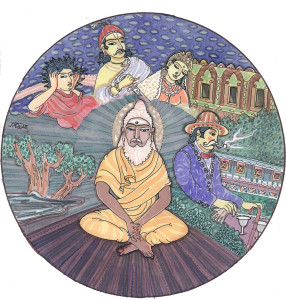
Lately, I’ve been playing around with shamanic journeying. Mostly just in my own house, while listening to recordings. In the past, I’ve done them in a group setting while a shaman filled the room with sage and steadily thumped on a drum. A fun experience, for sure. However, more than the fun, I’ve been particularly excited about comparing and contrasting the different methods of mind exploration.
In relation to mindfulness meditation, one big similarity is that they are both founded on a certain degree of mental stability or non-distractedness (aka samadhi). If a person intends to do some mind exploration, but is just lost in a sea of compulsive thinking, they won’t get very far in either. However, if they can take even a baby step beyond that, they’re in for a real treat.
As for the core difference, mindfulness is interested in the nature of experience while shamanic journeying is interested in the content of experience. Let’s unpack both of those interests.
For starters, mindfulness meditation roughly divides the entire world into two things: awareness and objects of awareness. The whole objective is just to be aware. What you are aware of is not important.
For example, to help themselves be aware, many people pay attention to a neutral object, like the breathing. When a thought or feeling spontaneously comes up, a mindfulness meditator won’t pay attention to the storyline (aka the content).
Instead, they’ll notice the nature of that thought or feeling: how it changes, how it seems like its “over there,” or perhaps its felt sense in the body. They just keep coming back to their neutral object and maintaining awareness, rather than veering off into the content of their thoughts.
The more they do this, the more they perceive the nature of thoughts, feelings and sensations. This perception directly leads to less reactivity, more groundedness, and a solid ability to follow through on an intention (like observing the breath, writing an essay or being kind to people no matter what).
Too much technical speak? Think about it like this:
To observe the nature of a deer is to just sit in a field and watch what it does, like a primitive scientist. How does it move? What does it sound like? Can you smell it? No story. Just raw observations, one after the other.
On the other hand, a shamanic journeyer directly engages with the story, with the content of their spontaneous thoughts, feelings and sensations. Usually, they’ll start with a prompt, like imagining they are climbing down into an underground tunnel, and going there with a powerful question—say, why bother getting out of the bed in the morning?
After initiating the journey, they release control and follow the thread of spontaneous thoughts and feelings. Say, a thought pops up that has them step from the tunnel into a dimly lit cave, where they see a little hedgehog that is scurrying along. They follow the hedgehog. A feeling of excitement floods them. The hedgehog leads to daylight, to an open field, where….
On a conscious level, they are simply choosing to follow the story of whatever pops into their mind. They are not choosing where the journey will end or what will happen along the way. They just follow. They are also not analyzing or interpreting what happens. They just follow.
This process goes right into the heart of whatever life content is up for us. Rather than meeting a therapist, a shamanic journey is like having an appointment with the subconscious mind—that’s what is “spontaneously” popping everything into the journey.
The net effect is insight into meaning, purpose and direction that can have a powerful impact on our life. There’s no better therapist than your own deeper intuition.
In summary, mindfulness observes the nature of the thread of feeling, thought and sensation without getting involved, without exploring the storyline. Shamanic journeys follow the thread and see where the subconscious takes it.
Both these methods offer a different superpower. For that alone, I highly recommend both. And, as a side benefit, they are also a lot of fun. For mind junkies like myself, exploring consciousness is one of the most exciting things possible!
Travel onwards!
*photo by Himalayan Academy Publications

Really really insightful. As i consider both, I find that mindfulness helps to root while letting go consciously for a period of time to explore consciousness is an art, and also happens safely in dreaming.
Beautiful description. Have you experimented with combining them? Perhaps not simultaneously, but let’s say while you are observing a pain and you start to lose equanimity, for example, you go journeying to understand the pain, explore its story, and then return to formal practice with a different perspective. I’ve tried some combinations and found them quite cool as a practice.
Would love to hear from you more about this
To be honest, it’s been a long time since I’ve done much with shamanic journeying, and when I did, I usually kept them separate. Although, it sounds like you’ve found combining them useful — the greatest teacher is always your own direct experience. I’d encourage you to trust that and keep exploring!